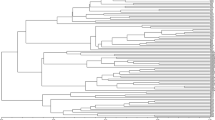Abstract
ISSR amplification was evaluated for its applicability to strawberry varietalidentification. Eighteen primers based on various di- tri- or tetra- SSR motifswith 3 or 0 5'-selective nucleotides for anchoring were screened against thestrawberry genome by agarose gel electrophoresis. PCR conditions wereoptimised to obtain high quality patterns. Five primers that gave informativepatterns were selected and used to characterise, by polyacrylamide gelelectrophoresis, 30 strawberry varieties of various geographic and geneticorigins. A total of 390 bands, 113 of which were polymorphic (30%),were generated using these five primers. Genetic similarity between varietieswas estimated using Jaccard's coefficient of similarity. The associationsbetween varieties revealed by UPGMA analysis were consistent withpedigree data. With only one primer, all the varieties were distinguishedincluding those with a common pedigree. Banding patterns were highlyreproducible for DNA samples extracted from different tissues (leaves,sepals, and rhizomes) of the same plant, or from different plants (clones)of the same variety. ISSR technique is therefore a potentially useful tool forthe identification of strawberry varieties because it is simple, fast,cost-effective, highly discriminant and highly reliable.
Similar content being viewed by others
References
Arnau, G. & M. Bourgoin, 1998. Applicability of Amplified Fragment Length Polymorphism Markers for Strawberry Cultivar Identification. International Union for the protection of new cultivars of plants. Fifth Session, Beltsville (USA), 28-30 September. Biochem Mol Techn 5: 1-6.
Blair, M.W., O. Panaud & S.R. McCouch, 1999. Inter-simple sequence repeat (ISSR) amplification for analysis of microsatellite motif frequency and fingerprinting in rice (Oryza sativa L.). Theor Appl Genet 98: 780-792.
Charters, Y.M., A. Robertson, M.J. Wilkinson & G. Ramsay, 1996. PCR analysis of oilseed rape cultivars (Brassica napus L. ssp. oleifera) using 5'-anchored simple sequence repeat (SSR) primers. Theor Appl Genet 92: 442-447.
Degani, C., L.J. Rowland, A. Levi, J.A. Hortynski & G.J. Galleta, 1998. DNA fingerprinting of strawberry (Fragaria ananassa) cultivars using randomly polymorphic DNA (RAPD) markers. Euphytica 102: 247-253.
Godwin, I.D., E.A. Aitken & L.W. Smith, 1997. Application of inter simple sequence repeat (ISSR) markers to plant genetics. Electrophoresis 18: 1524-1528.
Graham, J., R.J. McNicol & J.W. McNicol, 1996. A comparison of methods for the estimation of genetic diversity in strawberry cultivars. Theor Appl Genet 93: 402-406.
Hamada, H., M.G. Petrino & T. Kakunaga, 1982. A novel repeat element with Z-DNA-forming potential is widely found in evolutionarily diverse eukaryotic genomes. Proc natl Acad Sci USA 79: 6465-6469.
Hill, M., H. Witsenboer, M. Zabeau, P. Vos, R. Kesseli & R. Michelmore, 1996. PCR-based fingerprinting using AFLPs as tool for studying genetic relationships in Lactuca spp. Theor Appl Genet 93: 1202-1210.
Jain, A., C. Apparanda & P.L. Bhalla, 1999. Evaluation of genetic diversity and genome fingerprinting of Pandorea (Bignoniaceae) by RAPD and inter-SSR PCR. Genome 42: 714-719.
Kantety, R.V., X. Zeng, J. Bennetzen & B.E. Zehr, 1995. Assessment of genetic diversity in dent and popcorn (Zea mays L.) inbred lines using inter-simple sequence repeat (ISSR) amplification. Mol Breed 1: 365-373.
Klein-Lankhorst, R.M., A. Vermunt, R. Weide, T. Liharska & P. Zabel, 1991. Isolation of molecular markers for tomato (L. esculentum) using random amplified polymorphic DNA (RAPD). Theor Appl Genet 83: 108-114.
Landry, B.S., L. Rongqi & S. Khanizadeh, 1997. Classification of 75 strawberry cultivars and breeding lines using RAPD markers. Acta Hortic 439: 101-105.
McGregor C.E., C.A. Lambert, M.M. Greyling, J.H. Louw & L. Warnich, 2000. A comparative assessment of DNA fingerprinting techniques (RAPD, ISSR, AFLP and SSR) in tetraploid potato (Solanum tuberosum L.) germplasm. Euphytica 113: 135-144.
MacPherson, J.M., P.E. Eckstein, G.J. Scoles & A. Gajadhar, 1993. Variability of the random amplified polymorphic DNA assay among thermal cyclers, and effects of primer and DNA concentration. Mol cell Probes 7: 289-293.
Nagaoka, T. & Y. Ogihara, 1997. Applicability of inter-simple sequence repeat polymorphisms in wheat for use as DNA markers in comparison to RFLP and RAPD markers. Theor Appl Genet 94: 597-602.
Prevost, A. & M.J. Wilkinson, 1999. A new system of comparing PCR primers applied to ISSR fingerprinting of potato cultivars. Theor Appl Genet 98: 107-112.
Rogers, S.O. & J. Bendich, 1988. Extraction of DNA from plant tissues. Plant Mol Biol Man A6: 1-10.
Schierwater, B. & A. Ender, 1993. Different thermostable DNA polymerases may amplify different RAPD products. Nucl Acids Res 21: 4647-4648.
Skroch, P.W & J. Nienhuis, 1995. Impact of scoring error and reproducibility of RAPD data on RAPD-based estimates of genetic distance. Theor Appl Genet 91: 1086-1091.
Vasconcelos, M., E.G. Barros, M.A. Moreira & C. Vieira, 1996. Genetic diversity of the common bean Phaseolus vulgaris L. determined by DNA-based molecular markers. Brazil J Genet 19(3): 447-451.
Vos, P., R. Hogers, M. Bleeker, M. Reijans, T. Van de Lee, H. Hornes, A. Frijters, J. Pot, J. Peleman, M. Kuiper & M. Zabeau, 1995. AFLP: a new technique for DNA fingerprinting. Nucl Acids Res 23: 4407-4414.
Williams, J.G.K., A.R. Kubelik, K.J. Livak., J.A. Rafalski & S.V. Tingey, 1990. DNA polymorphisms amplified by arbitrary primers are useful as genetic markers. Nucl Acids Res 18: 6531-6535.
Wolff, K., E. Zietkiewicz & H. Hofstra, 1995. Identification of chrysanthemum cultivars and stability of DNA fingerprint patterns. Theor Appl Genet 91: 439-447.
Zietkiewicz, E., A. Rafalski & D. Labuda, 1994. Genome fingerprinting by simple sequence repeat (SSR)-anchored polymerase chain reaction amplification. Genomics 20: 176-183.
Author information
Authors and Affiliations
Rights and permissions
About this article
Cite this article
Arnau, G., Lallemand, J. & Bourgoin, M. Fast and reliable strawberry cultivar identification using inter simple sequence repeat (ISSR) amplification. Euphytica 129, 69–79 (2003). https://doi.org/10.1023/A:1021509206584
Issue Date:
DOI: https://doi.org/10.1023/A:1021509206584




